While employees have responsibilities to adhere to when it comes to the Health and Safety at Work Act, employers also have to follow the act, too, which is included in a contract that both employers and employees have to sign.
The main responsibilities that an employer has to work by under their own section of the Health and Safety at Work Act are the following:
1) It shall be the duty of the employer to ensure, so as far as reasonably practicable, the health, safety and welfare at work of all his employees.
This means that the employer is responsible for the welfare, health and safety wise, of their employees, within reason.
2) Without prejudice to the generality of an employer’s duty under the preceding subsection, the matters to which that duty extends include in particular—
(a) the provision and maintenance of plant and systems of work that are, so far as is reasonably practicable, safe and without risks to health;
'Plant and systems of work' mean any equipment that is supplied by the organisation/employee need to be safe to use for the employee or anyone else.
(b) arrangements for ensuring, so far as is reasonably practicable, safety and absence of risks to health in connection with the use, handling, storage and transport of articles and substances;
An employer mustn't put their employees at risk in regards to any physical means of work.
(c) the provision of such information, instruction, training and supervision as is necessary to ensure, so far as is reasonably practicable, the health and safety at work of his employees;
For the safety of the said employee/s, the employer must ensure that health and safety information is available, while instructing the employee/s where necessary, and making sure that training is provided, along with supervision if needed to carry out a particular task.
(d) so far as is reasonably practicable as regards any place of work under the employer’s control, the maintenance of it in a condition that is safe and without risks to health and the provision and maintenance of means of access to and egress from it that are safe and without such risks;
All places of work must be maintained at a standard that is 'safe and without risks to health'.
(e) the provision and maintenance of a working environment for his employees that is, so far as is reasonably practicable, safe, without risks to health, and adequate as regards facilities and arrangements for their welfare at work.
The working environment for the employee/s must be work-friendly in terms of safety. There should be facilities around if something were to go wrong (fire extinguishers for example) and arrangements made in case of a situation (fire drills, as another example).
3) Except in such cases as may be prescribed, it shall be the duty of every employer to prepare and as often as may be appropriate, revise a written statement of his general policy with respect to the health and safety at work of his employees and the organisation and arrangements for the time being in force for carrying out that policy, and to bring the statement and any revision of it to notice of all his employees.
Part 3 states that an employer must revise (where necessary) their general written statement policy regarding health and safety at work for their employers. Whatever organisation it may be must carry out these changes in the policy. If there is anything out of place with the written statement used, it must be brought to the attention of the employees at the organisation.
4) Regulations made by the Secretary of State may provide for the appointment in prescribed cases by recognised trade unions (within the meaning of the regulations) of safety representatives from amongst the employees, and those representatives shall represent the employees in consultations with the employers under subsection (6) below and shall have such other functions as may be prescribed.
The Secretary of State in the United Kingdom can be a number of people who are in charge of the the Government Department of the country. The most well known Secretary of State is the Prime Minister.
The safety representative will be someone who is employed in the organisation to make sure health and safety rules are followed, and that all employees remain protected.
5) (a section to sign)
6) It shall be the duty of every employer to consult any such representatives with a view to the making and maintenance of arrangements which will enable him and his employees to co-operate effectively in promoting and developing measures to ensure the health and safety at work of the employees, and in checking the effectiveness of such measures.
An employer must converse with any of the safety representatives to arrange (and ensure) the health and safety at work of the employee/s, making sure that these changes are effective.
7) In such cases as may be prescribed it shall be the duty of every employer, if requested to do so by the safety representatives mentioned in [F2subsection (4)] above, to establish, in accordance with regulations made by the Secretary of State, a safety committee having the function of keeping under review the measures taken to ensure the health and safety at work of his employees and such other functions as may be prescribed.
The laws made by the Secretary of State in regards to health and safety in the work place need to be adhered to by both the employer and representative, keeping all in employees safe in the process.



No comments:
Post a Comment